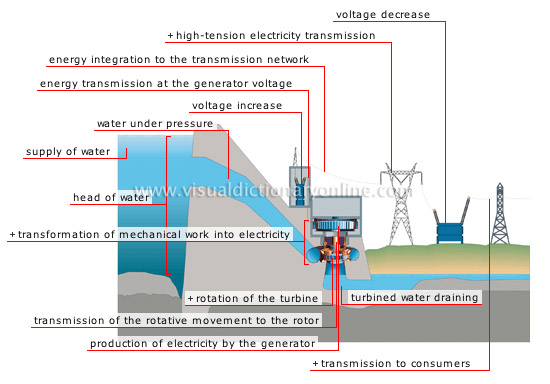steps in production of electricity
In a hydroelectric power plant, water is turned into electricity, which is carried to consumers along a transportation and distribution network.
turbined water draining 
After passing through the turbine, the water rejoins the watercourse.
transmission to consumers 
The electricity is carried to areas of consumption by low-voltage distribution lines.
voltage decrease 
Before integrating the electricity into the distribution network, the voltage is progressively decreased to 240 V.
high-tension electricity transmission 
Using high-voltage lines to transmit electricity over long distances reduces the strength of the current and, as a result, energy losses.
head of water 
The dam raises the water level to create a vertical drop along the length of the penstock.
water under pressure 
The water takes on energy as it flows down the penstock and is carried with force to the turbine.
transmission of the rotative movement to the rotor 
The movement of the turbine is transmitted to the rotor by the shaft.
rotation of the turbine 
Flowing water applies pressure to the turbine’s blades to make it turn.
production of electricity by the generator 
The generator produces electricity through the movement of the rotor in the stator.
energy integration to the transmission network 
The electricity produced is integrated into the network.
voltage increase 
At the outlet end of the power plant, the transformer increases the voltage; this reduces energy losses during transmission over long distances.
energy transmission at the generator voltage 
Electric power produced by the generator is transmitted to a transformer at the power plant outlet.
supply of water 
Basin created by building a dam, which holds back a large volume of water.














